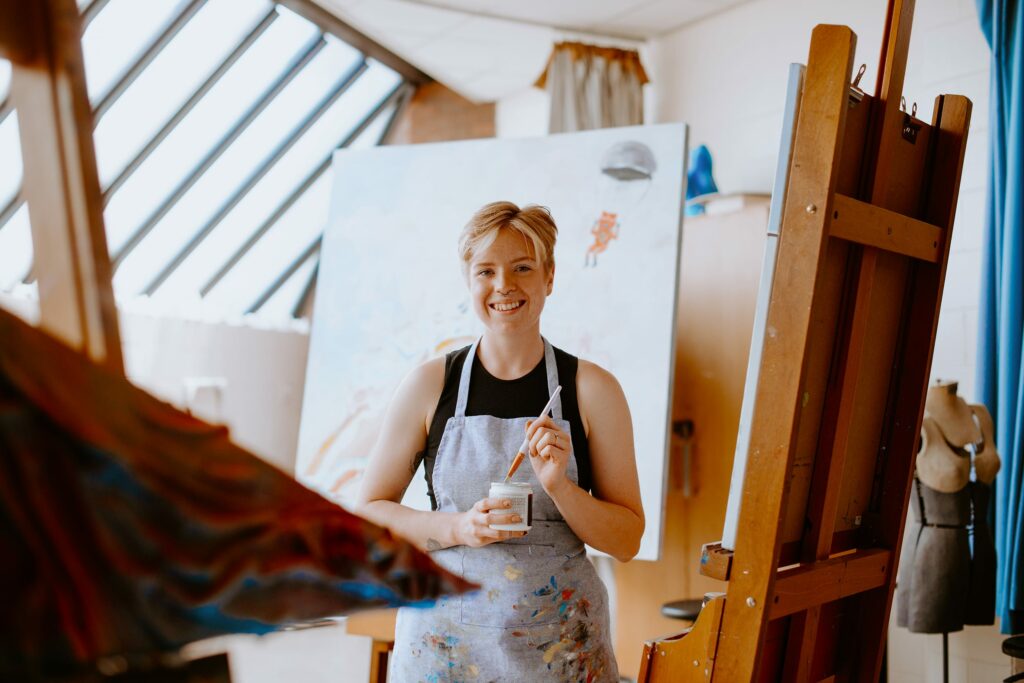

Key Details
Program Start Dates
September 2026
Please visit Ontario College Application Service to learn more about start dates.
Program Contacts
Program Coordinator / Professor
Program Overview

Ignite your imagination: Learn to animate in 2D and 3D
Do you dream of working in the animated film, television, or gaming industry? Your drawing and storytelling skills will come alive as we help you develop your drawing and storytelling skills through the 12 principles of animation. With regular access to industry-standard software and hardware in our 13,900-square-foot studio, you’ll apply traditional techniques to 2D and 3D animation and gain a basic understanding of the animation process.
When you graduate, you can use your portfolio to jump into the field as an animation generalist, or continue your education and join the final year of Cambrian College’s three-year advanced diploma Animation program where you can specialize in either 2D or 3D animation.
Program Highlights
Program highlights
- Develop dynamic storytelling, drawing, design, and animation skills
- Graduate with a production-ready portfolio
- Toon Boom Centre of Excellence program
- Opportunity to showcase your work to industry representatives on a field trip to Toronto
- Grads can enter directly into the third year of Cambrian’s Animation advanced diploma program
Admissions
Admissions requirements
For graduates of the new curriculum (OSS): Ontario Secondary School Diploma (30 credits) or equivalent or mature student status including:
- Any grade 12 English (C) or (U)
- Submission of a portfolio (see additional admission requirements)
International Student Admissions
Are you an international student? Learn more about additional requirements.
Learn moreAdditional admission requirements
Portfolio requirements
In order to be accepted for admission in Cambrian College’s Animation program, students are required to submit a portfolio. All entries should be submitted on 8 1/2" x 11" paper (no original artwork) and should include the following elements:
Life Studies
Two (2) drawings are from life, either a human model or an animal. The drawings should reflect an attempt to understand:
- Structure and anatomy
- Proportion
- Perspective
- Mass and volume
- Visual appeal and rhythm
- Balance
One (1) drawing of the artist’s hand and forearm that shows and understanding of the above elements. The drawing can be loose.
Character Study
Design a character and draw this character in a variety of poses (minimum of 5 poses). Each pose should show a different emotion. It is important to think about the character as an actor. Students should pay close attention to the following:
- Structure and solid 3D construction
- Perspective
- Mass and volume
- Appeal
- Continuity of model (is it the same character in each pose?)
Perspective Study
One (1) drawing of a room in your home. This drawing should showcase knowledge of the following:
- Perspective
- Depth and 3D space
- Proportion
- Visual appeal
This drawing should be a clean line drawing.
Personal Work
Six (6) to ten (10) pieces that reflect your style and skill. These can be drawings and paintings. If you would like you can show a mix of classical and digital art.
Submission Process
Please mail your portfolio to the following address:
James Munro
c/o Cambrian College
1400 Barry Downe Road
Sudbury, ON, Canada
P3A 3V8
Portfolios can also be submitted digitally to the following email address: james.munro@cambriancollege.ca.
Remember, presentation says a lot about who you are and your work ethic. Good luck!
Recommended:
- Grade 11 or 12 credits in visual arts and/or media arts (M) or (O)

Academic Upgrading
Are you missing admission requirements? Strengthen your academic skills for free at your own pace through Academic Upgrading!
Program delivery
Program delivery
2026-2027
Fall term start
- Semester 1: Fall 2026
- Semester 2: Winter 2027
- Semester 3: Fall 2027
- Semester 4: Winter 2028
Program of Study
Program of study for 2026-27 Academic Year
| Semester 1 | Credits | |
|---|---|---|
| ANI 1130 | Life Drawing | 4 |
| ANI 1131 | Drawing for Animation | 4 |
| ANI 1132 | Intro to Animation Principles | 4 |
| ANI 1133 | Intro to Drawing and Painting | 2 |
| ANI 1134 | Digital Tools | 2 |
| ANI 1135 | Visual Language | 2 |
| COM 1001 | Art and Design Communication | 3 |
| IND 1105 | Decolonizing the Creative Arts | 1 |
| Credits | 22 | |
| Semester 2 | ||
| ANI 2130 | Life Drawing II | 3 |
| ANI 2131 | Introduction to Design | 2 |
| ANI 2132 | Body Mechanics | 3 |
| ANI 2133 | Drawing and Painting | 2 |
| ANI 2134 | Intro to 3D | 3 |
| ANI 2135 | Intro to 2D Rigging | 3 |
| ANI 2136 | Story Concepts | 2 |
| One General Education Course. 1 | 3 | |
| Credits | 21 | |
| Semester 3 | ||
| ANI 3130 | Life Drawing III | 3 |
| ANI 3131 | Development and Design | 2 |
| ANI 3132 | Action Analysis | 4 |
| ANI 3133 | 3D Animation I | 3 |
| ANI 3134 | Layout I | 2 |
| ANI 3135 | Story and Visual Narrative | 2 |
| ANI 3136 | Intro to Modelling | 2 |
| One General Education Course. 1 | 3 | |
| Credits | 21 | |
| Semester 4 | ||
| ANI 4130 | Life Drawing IV | 3 |
| ANI 4131 | Character Design | 2 |
| ANI 4132 | Acting for Animation | 4 |
| ANI 4133 | 3D Animation II | 3 |
| ANI 4134 | Layout II | 2 |
| ANI 4135 | Story and Visual Narrative II | 2 |
| ANI 4136 | Portfolio Development | 2 |
| One General Education Course. 1 | 3 | |
| Credits | 21 | |
| Total Credits | 85 | |
- 1
-
For more information regarding General Education courses, click here.
Fees
Tuition Cost
Important Notice
Fees presented are estimates based on projections for future academic year(s) of study. Actual fees charged may differ from what is published here. A full detailed listing of all fees is available in myCambrian and updated annually no later than May 1 for the following academic year. Students in Academic Upgrading are responsible for any fees listed on their invoice each term.
Tuition and ancillary fees
Please see our fees page for the breakdown of tuition and mandatory ancillary fees by program and semester for both domestic and international students.
Books and supplies
Books and supplies may be required at the course level over and above what is estimated above. Please consult your professor/instructor and course outlines for further information.

College may be more affordable than you think!
Have you said, “school can wait another year”? Don’t sacrifice your future any longer – you can do it!
Whether it’s fear, financial reasons, or something else that is impacting your decision to start school, we’re here to listen to you and help in any way we can!
Work-integrated learning (WIL)
Take your education beyond the classroom!
Cambrian programs blend academic learning, hands-on training, and community involvement opportunities to help you achieve your ultimate goal – your dream career. You’ll have the opportunity to apply your knowledge to real-world scenarios within and outside of the classroom through work-integrated learning. Whether it be a capstone project, co-op, practicum, preceptorship component, or placement, you’ll benefit from a practical, job-related experience before you graduate.
Work Integrated Learning (WIL) resources
Your program may give you the opportunity to gain practical work experience through a capstone project, co-op, practicum, preceptorship component, or placement. Before starting your program it’s important to understand the differences between the opportunities as well as the requirements.
Field of Study
School of Creative Industries
Looking to further your craft and pursue a career where your creativity can lead to a fulfilling career? At Cambrian, a program in Creative Industries allows you to tap into your talents and develop skills that can allow you to pursue that ideal job. You’ll learn from industry professionals who have been able to create and succeed in the modern workplace.
Career Outcomes



Need a career coach?
Explore how this program can lead to a great career! Cambrian’s Career Coach platform is a user-friendly, online tool that provides up-to-date and comprehensive labour market data to help you explore career options, salary expectations for the Greater Sudbury region, and more!

See where you'll be learning!
Minimum technology requirements
Success in this program requires that you come equipped with some program-specific technology requirements.
Minimum technology requirements
Our animation labs are fully equipped with all of the hardware and software that are required to complete this program. If you would like to invest in your own equipment, here is a list of the suggested minimum technology requirements:
- Regular access to a computer with a reliable Internet connection
- Webcam and headset
- Personal computer (PC)
- Windows 7 (SP1), 8, 8.1, or 10 operating system (OS 10 preferred)
- Processor: 64-bit Intel or AMD multicore processor, Intel i5 minimum or AMD equivalent
- RAM: 8 GB (16 GB preferred)
- External hard drive: SSD 256 GB minimum
- Video card: Most cards manufactured 2018 or newer, must support OpenGL 3.3 or higher
- Storage space: 100 GB free with minimum 10 GB for software installs
- Monitor: 1280 x 1040 resolution with 32-bit colour minimum
- Mouse: 3-button
- Pen tablet: Wacom
- Software: Autodesk (Maya, Mudbox), Toonboom (Harmony, Storyboard Pro), Adobe (Photoshop, Premiere, Animate, Acrobat), Audacity, Unreal Engine, Quicktime, Google Chrome, WinZIP/7ZIP, FlipBook, xNormals
Required software will be provided by Cambrian College. Instruction on how to obtain software will be provided to you. Some software that you may access as part of your program may not be compatible with every device. If you have any questions about these technology requirements, please email info@cambriancollege.ca or call (705) 566-8101, ext. 7303.
System requirements for assistive technology
To access the widest range of assistive technology (AT), a Windows-based computer is recommended.
- Recommended OS: Windows 10 or newer
- Recommended CPU: Intel or AMD multicore processor
- Recommended RAM: 8 GB
- Recommended storage for assistive technology: 8 GB of available hard drive of solid state drive space (please note this is not the total drive size and refers specifically to available space needed for assistive technology)
- Recommended audio: Speakers or headphones for text-to-speech and microphone for speech input
While Apple computers can provide many AT options, some specialized software may not be available/compatible with this platform. Please consult with the Glenn Crombie Centre for further details.

Ready to take the first step?
Start gaining the highest level of skills at Cambrian now – and you’ll be ready to take advantage of the many career opportunities waiting for you just around the corner. The future is yours!
Have Questions? We are here to help.
If you have any questions about programs, funding, OSAP, deadlines, student services, or anything else, reach out to our support team and we are happy to help!
Related Programs

